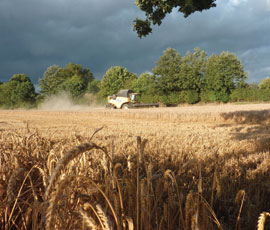Dismal harvest is best forgotten

Harvest 2012 is one many farmers will want to forget. Appalling weather meant not only did crops fail to reach their potential, they were difficult to get in, with too many wet days and sticky ground conditions to boot.
Despite coming into the spring with drought across much of England, the summer became the wettest in 100 years. The lack of sunshine also made it one of the dullest on record, resulting in high disease pressure and very poor grain fill.
Many crops had suffered from aphid attacks in the autumn and spring, said Agrii agronomist David Neale.
Almost incessant rain from April onwards meant many people struggled to get sprays on at the right time, and disease pressures included yellow and brown rust, septoria and late fusarium.
“There was a very long flowering period, ending up with lots of blind sites and shrivelled grains – I’ve never seen anything like it,” he said. Bushel weights were, therefore, low and many samples had high levels of screenings.
“Anything grown on free-draining soils has had the edge – crops that sat in waterlogged soils would have had restricted nutrient uptake and root problems.”
KEY POINTSHighs
- Milling quality held up better than feed
- Early varieties and lighter land fared best
Lows
Appalling weather led to poor bushel weights Below average yields
Wheat yields had been extremely variable, with some as much as 50% below normal, he said. “On average, they’re probably 25% down at about 6.5t/ha – very few have come in average or above.
There have been so many influences on yield – is it soil type, location, variety, spray programme, or weather? In most cases it won’t just be one factor in isolation.”
Trial results from Syngenta suggested that early maturing varieties such as Gallant and Solstice had performed better than later varieties this year, producing around 80% bold grains, compared with Invicta and Oakley at only 40%.
“Septoria has been a big issue, and every crop has been under a great deal of stress,” said cereals crop team agronomist James Evans. “The early varieties have tolerated the disease pressure better than the later ones.”
HGCA trials came in 0.8t/ha below the five-year mean, at 9.63t/ha, with well-established feed varieties performing well. Santiago yielded 108%, with Diego at 104%, and new varieties Gator and Relay at 102% and 97%, respectively. Horatio, a new soft Group 4 variety, achieved 103%.
Group 3 variety Torch matched its average treated yield at 103%, but its untreated yield broke records for all the wrong reasons, said Simon Oxley, Recommended List manager at HGCA. Breakdowns in yellow rust meant its untreated yield came in at just 58% of the mean, with only Oakley doing worse at 57%.
“That is a long way for a variety to fall if you get the fungicides wrong, and we would welcome more fundamental research into the durability of disease resistance in varieties.”
In the milling sector, Crusoe yielded well, at 101%, with its untreated yield also holding up well at 114% of the control.
Gallant, Cordiale and Solstice outperformed their five-year averages, at 105%, 101%, and 99% respectively, while KWS Sterling was unexciting at 93%.
New candidate varieties had a slow start, said Mr Oxley. Cougar, Torphins, Yaris and Kielder had not matched the five-year mean, but Leeds and Rowan looked more promising, he added.
Preliminary quality results confirmed the drop in bushel weights, to an average of 71.9kg/hl; 8% below the three-year average and among the lowest on record, said senior HGCA analyst Charlotte Garbutt.
Samples ranged from 54kg to 80kg/hl, although milling varieties held up better than feed strains. Hagberg Falling Numbers were a touch lower than normal, at 267 seconds, but protein contents were on the high side, at 12.7%.
“However, with only 40% of GB wheat harvested (as Crops went to press), the estimates are focused on south-east and eastern regions, where drier weather has allowed progress,” she said.
“The survey is also biased towards earlier harvested bread milling wheat so figures can be expected to change when more Group 3 and 4 varieties have been harvested.”
Yields in East Anglia had been extremely variable, but milling wheat varieties had fared better than feed crops, said Rob Munro at Fengrain. “Yields have been disappointing, and there is huge variance in quality, both around the region, on farm, and even within loads.”
He reckoned 60-70% of milling wheat varieties would be usable, with more downgraded to feed than normal. “Bushel weights range from 50kg/hl to 72kg/hl, and Hagbergs have slipped, although they are still at usable levels.”
Keep track of harvest with Farmers Weekly’s Harvest Highlights service, including news from your region
How do your wheat yields compare with the regional average? See the latest figures and submit your own results
See the latest HGCA Recommended List harvest results on our dedicated web page

